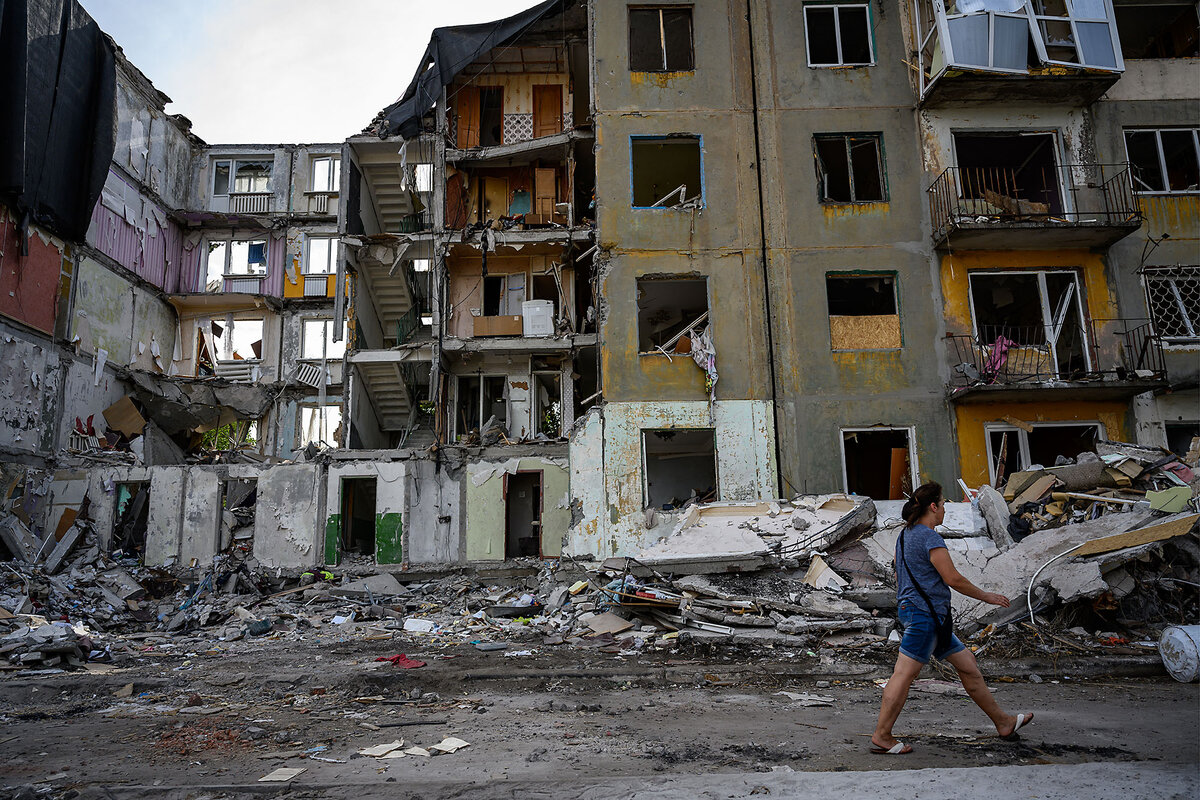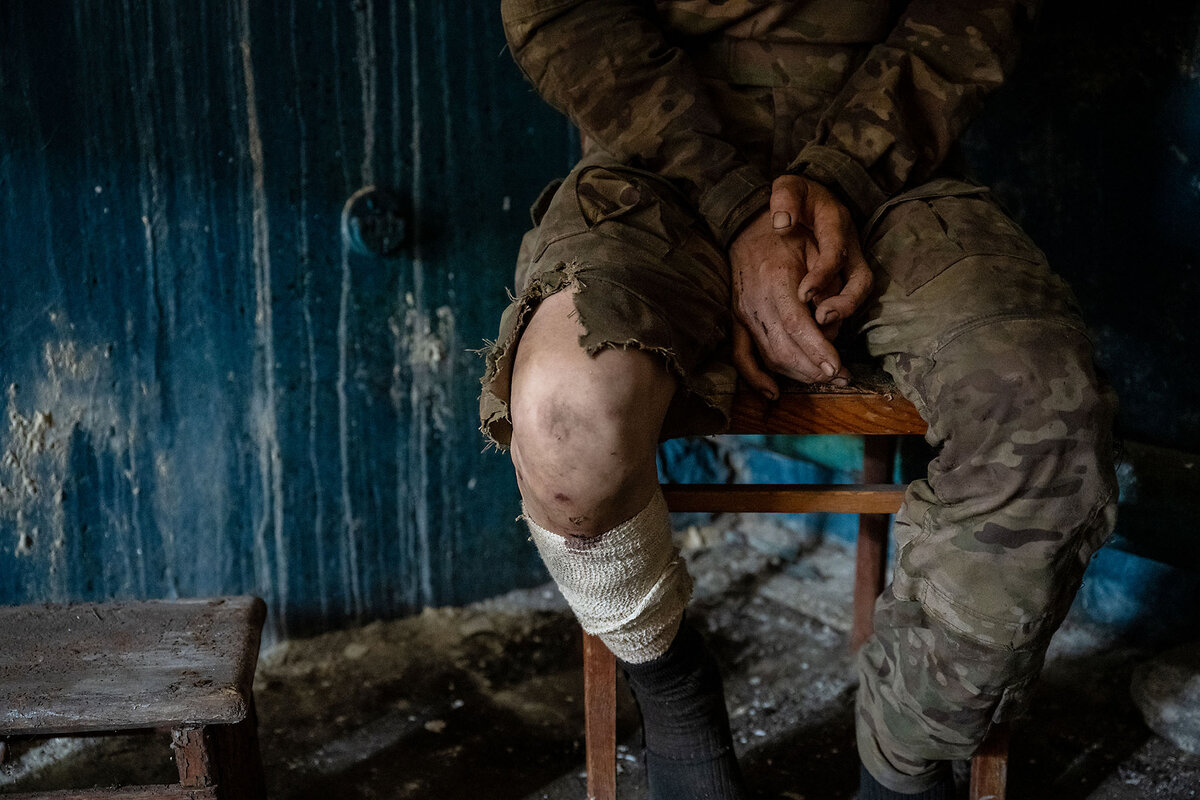Russian POWs recount fear, and horrific cost, of battling dug-in Ukrainians
Loading...
| Eastern Ukraine
Nothing prepared the Russian soldier for the brutal reality of combat he experienced this summer in eastern Ukraine – nor for the “meat assault” he was ordered to lead.
The soldier, who gives the name Sergei, and is now a prisoner of the Ukrainians, recalls being shocked by the visibly high cost of small battlefield gains: dead Russian and Ukrainian soldiers everywhere.
Why We Wrote This
The path of two prisoners of war, from induction in Russia to captivity in Ukraine, was arduous, filled with broken promises, insufficient training, and poor equipment. But having survived, they offer insight into Russia’s brutal, yet effective, battle plan.
The apocalyptic scene was a far cry, he says, from the army recruiter’s promise that he would be assigned a safe job inside Russia, on border patrol. Instead, with little training, he was ordered to lead a squad across open ground against dug-in Ukrainian troops.
The Monitor interviewed two Russian prisoners of war as Russian forces made small but steady advances along the entire eastern front. The stark picture they present is necessarily one fragment of the Russian military effort, which has leveraged its manpower advantage by throwing troops at Ukrainian lines in costly waves.
Sergei says he refused to lead the attack, arguing that it was a “suicide mission.” He was sent on it anyway, with this threat ringing in his ears: “‘If you come back,’” he says his commander warned him, “‘I will kill you myself.’”
Nothing prepared the Russian soldier for the violent, brutal reality of combat he experienced this summer in eastern Ukraine – nor for the “meat assault” he was ordered to lead.
The soldier, who gives the name Sergei, arrived at the front in late June, in a town freshly occupied by Russia. He recalls being shocked by the visibly high cost of small battlefield gains: dead Russian and Ukrainian soldiers littering the streets.
The apocalyptic scene was a far cry, he says, from the promise of his army recruiter that he would be assigned a safe job inside Russia, on border patrol.
Why We Wrote This
The path of two prisoners of war, from induction in Russia to captivity in Ukraine, was arduous, filled with broken promises, insufficient training, and poor equipment. But having survived, they offer insight into Russia’s brutal, yet effective, battle plan.
Instead, wearing a uniform with sewn-in knee pads that he had to purchase himself – and with little training and an abusive commander – he was ordered to lead a squad across open ground against Ukrainian troops entrenched in a forest line.
“The first thing I felt was fear,” says the 30-something Russian soldier, now a prisoner of the Ukrainians, with a tremble of emotion in his voice at the memory. “When I saw what that village looked like, I was terrified.”
When the order came to attack soon after his arrival, “no one wanted to go,” recalls Sergei. “We were pushed by our commanders, ‘Just go, go, go forward.’ They would not let us go back ... even though we knew we were having huge losses. They were using us as meat.”
Of the 14 men in Sergei’s unit, six died and seven were wounded in just five days.
Sergei says he refused to lead the attack, arguing that it was a “suicide mission.” He was sent on it anyway, though not as the squad leader, with this threat ringing in his ears: “‘If you come back,’” he says his commander warned him, “‘I will kill you myself.’”
During that assault, a shell landed on a dugout the Russians were in, breaking one soldier’s leg. Sergei says he stayed with the wounded man for a day while the others fled. Radio calls for help went unanswered.
Eventually Sergei laid down his gun, removed his grenades and magazines of bullets, and stood up with hands raised. He walked toward Ukrainian lines, shouting, “I give up!”
Grateful to be alive
In July, The Christian Science Monitor interviewed two Russian prisoners of war captured separately days earlier in eastern Ukraine, as Russian forces made small but steady advances along the entire eastern front. They were forlorn and looked lost, but also expressed appreciation that they were still alive, when so many of their fellow Russian soldiers were not.
Their stories provide rare insight into the Russian side of the front lines. They describe low levels of motivation to fight and low morale, 2 1/2 years after Russia’s invasion.
Ukrainian intelligence officers brought both men, whose hands had been taped over their faces during transport behind tinted windows on public roads, and unbound them for lengthy interviews in an abandoned garage in eastern Ukraine.
Neither Russian POW appeared to have suffered any physical harm in captivity, though the right knee of one soldier, who gives the name Arsen, was evidently wounded and bandaged. That happened before his capture, he says.
Nor did the prisoners appear to speak under duress, though Ukrainian officers remained in the room throughout the interviews.
The Monitor is not publishing the Russian soldiers’ full names or other identifying details, in keeping with guidelines in the Geneva Conventions that prohibit public disclosure of such information.
The stark picture these first-time soldiers present of life and death in the Russian trenches is necessarily one fragment of a much broader mosaic of the Russian military effort. A large Russian offensive toward Kharkiv failed in May, for example.
But all along the front, Russia also continues to achieve incremental gains by leveraging its manpower advantage – and by throwing troops at Ukrainian lines in costly waves, known by both sides as “meat assaults.”
Trapped on “a one-way road”
That was where Sergei found himself in late June, caught in a collapsed bunker where, he says, he “knew it was the end.”
“The first thing I was told was, ‘Don’t give up, you will surely be killed, and it is better to die fighting,’” says the Russian prisoner, wearing a soiled dark green sweater and boots with the laces removed, his fingers stained with dirt.
“Of course, along the way we met some people who had high spirits, and they were even ready to fight,” recalls Sergei. “But the moment they got here ... they realized this was just a one-way road.”
“I don’t think there is a chance for Russia to win this war,” he says.
“I just hope that, sooner or later, this will bring all our [Russian] nation an understanding that a terrible thing is going on, we are paying a huge price, the suffering is enormous, and we have a lot of dead people,” says Sergei.
“I hope people will understand that, and turn off those televisions, that news, because there is a catastrophe going on,” the prisoner says. “There are not unlimited human resources we have in Russia – huge numbers of people are dying.”
Britain’s Ministry of Defence calculates that Russia has lost well over 1,000 soldiers per day, dead or wounded, throughout May, June, and July. The volume of Russian troops has piled “pressure” onto Ukrainian lines, it said, but “an effective Ukrainian defense and lack of Russian training reduces Russia’s ability to exploit any tactical successes.”
Videos filmed by Russian soldiers and circulating online include one seven-minute film, apparently taken after the capture of Avdiivka in February. In the video, a Russian soldier walks along an exposed, postbattle trench line that he calls a “road of death,” due to the trail of dead soldiers in the mud every few feet.
Two weeks of training, and rusty rifles
Russian prisoner of war Arsen says he had higher expectations of the Russian army – fed by propaganda TV reports about the war – than “meat assaults.” When he signed up in January, he was told that he would be posted in a rear “backup” position, digging trenches.
Arsen was given two weeks of “good training,” he says, about how to assault trenches, lay mines, and demine territory, as well as perform basic first aid. And then a truck arrived to outfit the unit, loaded with rifles that were old and rusty, and body armor that was dirty and sometimes riven with bullet holes.
“It was like a process of disappointment,” says Arsen, his fingers toying with the torn threads of his trousers, cut above the bandage on his shin. He limps when he moves, and wears no boots, but only a pair of black socks on his feet.
“None of the people I was with had the spirit to fight,” says Arsen. “Just before this task [order to advance], a lot of people refused and were beaten.”
Russian officers would single out wavering foot soldiers for a “preventive talk,” he says, which often included beating with sticks, though he was not beaten himself.
Instead, when ordered to run to join fellow Russian soldiers at a front-line dugout at night, Arsen inadvertently ran too far, directly into Ukrainian positions. When he heard the Ukrainians shout, he realized his mistake.
“I was very surprised they didn’t shoot me immediately,” says Arsen, a tear at the memory mingling with sweat and rolling down his nose in the hot room.
“I don’t really think Russia can succeed in [Ukraine]; their only tactic is these assaults,” says Arsen. “What impressed me was the weakness of the Russian forces – it is not what we see on Russian TV. If I will go back [to Russia], it is better to sit in prison than to come back here and fight.”
One Ukrainian intelligence officer, who was in the room during the interviews with the Russians, says he is wary about reading too much benefit for Ukraine in the descriptions of a Russian front-line defined by lack of morale and sparse training.
“It doesn’t give us a lot of inspiration, because there are still a lot of them [Russian soldiers], and still they are motivated by fear [and] they will be shot” if they retreat, says the intelligence officer, when asked later about their statements.
“Sometimes an [anti-Ukraine] ideology is driving people, but not often,” he says of Russian soldiers. “If 10 unprepared people are shooting at you, one will get you. It’s a very simple tactic. They must take the position, or they are done. They can’t come back.”
Oleksandr Naselenko supported reporting for this story.










